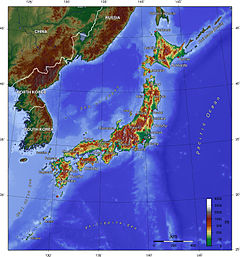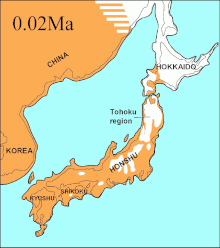Japanese archipelago: Difference between revisions
Undid revision 561330570 by 75.70.142.23 (talk) not sure what your dispute is, but article maintenance tags go at the top of the article |
specify which sentence is unsourced, and then add the tag starting from that position. or remove the tag |
||
| Line 1: | Line 1: | ||
| ⚫ | |||
{{Cleanup-link rot|date=June 2013}} |
{{Cleanup-link rot|date=June 2013}} |
||
[[File:Japan topo en.jpg|thumb|240px|[[Topographic map]] of Japan]] |
[[File:Japan topo en.jpg|thumb|240px|[[Topographic map]] of Japan]] |
||
| Line 5: | Line 4: | ||
The {{nihongo|'''Japanese archipelago'''|日本列島|Nihon Rettō}} are the islands that form the country of Japan, extends roughly from northeast to southwest along the northeastern coast of the [[Eurasia]] mainland, washing upon the northwestern shores of the [[Pacific Ocean]]. It consists of islands from the [[Sakhalin island arc]] and the [[Northeastern Japan arc]]. The main island is [[Honshu]].<ref>http://www.thefreedictionary.com/Japanese+Archipelago</ref> |
The {{nihongo|'''Japanese archipelago'''|日本列島|Nihon Rettō}} are the islands that form the country of Japan, extends roughly from northeast to southwest along the northeastern coast of the [[Eurasia]] mainland, washing upon the northwestern shores of the [[Pacific Ocean]]. It consists of islands from the [[Sakhalin island arc]] and the [[Northeastern Japan arc]]. The main island is [[Honshu]].<ref>http://www.thefreedictionary.com/Japanese+Archipelago</ref> |
||
| ⚫ | |||
The term ''Home Islands'' was used at the end of [[World War II]] to define the area of Japan to which its sovereignty and the constitutional rule of the [[Emperor of Japan|Emperor]] would be restricted.{{citation needed|date=June 2013}} The term is also commonly used today to distinguish the archipelago from Japan's colonies and other territories in the first half of the 20th century, but is not used in reference to the country as it exists today.{{citation needed|date=June 2013}} |
The term ''Home Islands'' was used at the end of [[World War II]] to define the area of Japan to which its sovereignty and the constitutional rule of the [[Emperor of Japan|Emperor]] would be restricted.{{citation needed|date=June 2013}} The term is also commonly used today to distinguish the archipelago from Japan's colonies and other territories in the first half of the 20th century, but is not used in reference to the country as it exists today.{{citation needed|date=June 2013}} |
||
Revision as of 08:49, 24 June 2013


The Japanese archipelago (日本列島, Nihon Rettō) are the islands that form the country of Japan, extends roughly from northeast to southwest along the northeastern coast of the Eurasia mainland, washing upon the northwestern shores of the Pacific Ocean. It consists of islands from the Sakhalin island arc and the Northeastern Japan arc. The main island is Honshu.[1]
This article needs additional citations for verification. (June 2013) |
The term Home Islands was used at the end of World War II to define the area of Japan to which its sovereignty and the constitutional rule of the Emperor would be restricted.[citation needed] The term is also commonly used today to distinguish the archipelago from Japan's colonies and other territories in the first half of the 20th century, but is not used in reference to the country as it exists today.[citation needed]
Island components
The archipelago consists of 6,852 islands ("island" defined as land more than 100 m in circumference), of which 430 are inhabited.[2] The four main islands, from north to south, are Hokkaido, Honshu, Shikoku, and Kyushu.
Palaeogeography
Changes to the Japanese archipelago over time:



| – regions above sea level | |
| (white color) – unvegetated land | |
| – sea |
See also
References
External links
- 37°30′52″N 137°42′44″E / 37.514444°N 137.712222°E, center of mass
